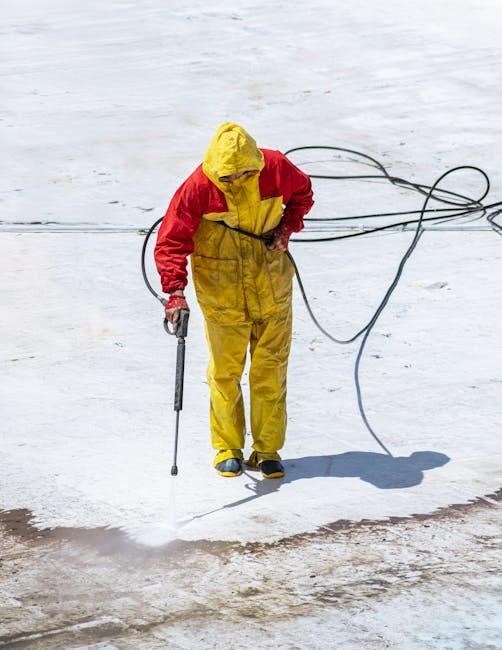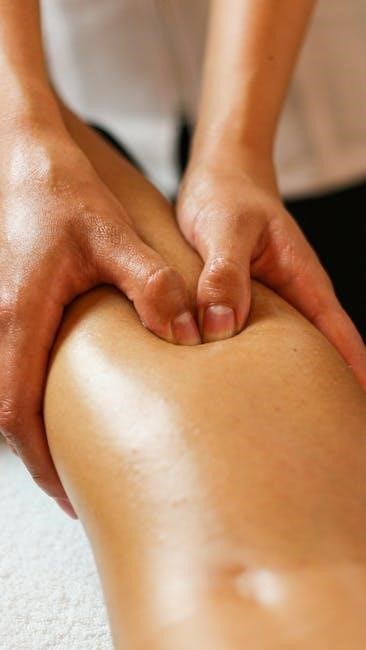Welcome to the Troy Bilt 3000 PSI Pressure Washer manual. This guide provides essential information for safe and effective operation, maintenance, and troubleshooting of your unit.
The Troy Bilt 3000 PSI Pressure Washer is a powerful and versatile cleaning tool designed for various outdoor tasks, offering durability and efficiency for years of reliable service.
By following the instructions in this manual, you’ll maximize performance, ensure safety, and extend the lifespan of your pressure washer. Read carefully before initial use.
This manual covers assembly, operation, maintenance, and troubleshooting, ensuring you get the most out of your Troy Bilt Xp 3000 PSI Pressure Washer.
Thank you for choosing Troy Bilt, a trusted brand committed to quality and customer satisfaction. Happy cleaning with your new pressure washer!
1.1 Overview of the Troy Bilt 3000 PSI Pressure Washer
The Troy Bilt 3000 PSI Pressure Washer is a high-performance cleaning tool designed for heavy-duty outdoor tasks. With a powerful engine and durable construction, it delivers reliable service for years. Its 3000 PSI rating makes it ideal for cleaning driveways, decks, and siding. The unit features an easy-to-use design, portability, and eco-friendly operation. This pressure washer is built to handle tough jobs efficiently while ensuring safety and longevity. It’s a versatile solution for homeowners seeking a dependable and powerful cleaning companion.
1.2 Importance of Reading the Manual
Reading the manual is crucial for safe, effective, and proper operation of the Troy Bilt 3000 PSI Pressure Washer. It provides essential safety guidelines, operation instructions, and troubleshooting tips to ensure optimal performance. Understanding the manual helps prevent accidents, voiding the warranty, and damaging the unit. It also guides you on maintaining the pressure washer, ensuring longevity and efficiency. By following the manual, you can address common issues and make informed decisions for repairs. This comprehensive guide is your key to maximizing the potential of your Troy Bilt 3000 PSI Pressure Washer while staying safe and efficient.
1.3 Safety Information and Precautions
Safety is paramount when operating the Troy Bilt 3000 PSI Pressure Washer. Always wear protective gear, including gloves and eyewear, to prevent injury from high-pressure jets or debris. Avoid using the washer near open flames or sparks, as fuel vapors can ignite. Keep children and pets away during operation. Never point the spray gun at people or animals. Ensure the area is clear of obstacles and avoid using the washer in wet conditions to prevent electrical hazards. Proper storage in a dry, ventilated area is essential to maintain safety and longevity. Follow all precautions to ensure safe and effective use.

Safety Information and Precautions
Always follow safety guidelines to prevent accidents. Read the manual thoroughly, ensure proper usage, and adhere to manufacturer instructions for safe and effective operation of your pressure washer.
2.1 General Safety Guidelines
Always wear protective gear, including safety glasses and gloves, when operating the pressure washer. Ensure the area is clear of obstacles and keep children away. Avoid using the pressure washer near open flames or sparks. Never point the spray gun at people or animals. Use the correct nozzle for the task to prevent accidental damage. Keep the pressure washer on a stable surface and avoid overreaching. Follow all manufacturer instructions and safety precautions to minimize risks and ensure safe operation. Regularly inspect equipment for damage or wear. Proper usage and adherence to guidelines are essential for preventing accidents and maintaining efficiency.
2.2 Safety Symbols and Their Meanings
This section explains the safety symbols used in this manual to alert you to potential hazards; The warning symbol indicates a potentially dangerous situation that could result in serious injury or death. The caution symbol highlights actions that may cause minor injury or damage. The notice symbol provides important information for proper operation and maintenance. Always pay attention to these symbols and follow the instructions provided to ensure safe and effective use of your Troy Bilt 3000 PSI Pressure Washer.
2.3 Handling Fuel and Chemicals Safely
Always handle fuel and chemicals with care to avoid accidents. Store gasoline in approved containers, away from open flames or sparks. Use the recommended detergent and chemicals only, as specified in the manual. Avoid overfilling the detergent tank to prevent spills. Wear protective gloves and eyewear when handling chemicals. Keep fuel and chemicals out of reach of children and pets. Never mix leftover fuel or chemicals with new ones. Dispose of unused or expired chemicals responsibly, following local regulations.
Refer to the safety symbols in this manual, such as the ⛔ warning and ✅ caution symbols, for specific guidance on handling hazardous materials. Ensure proper ventilation when working with fuel or chemicals to prevent inhaling fumes. Never smoke or use open flames near fuel or chemical storage areas. Always follow the manufacturer’s instructions for fuel and chemical usage to ensure safe operation of your Troy Bilt 3000 PSI Pressure Washer.
2.4 Storage and Maintenance Safety Tips
Store the pressure washer in a dry, well-ventilated area, away from direct sunlight and moisture. Always drain the fuel tank and hoses before long-term storage to prevent corrosion and damage. Clean the unit thoroughly after each use to remove dirt and debris. For winter storage, winterize the pressure washer by draining all fluids and adding a fuel stabilizer. Keep the pressure washer out of reach of children and pets. Regularly inspect hoses and connections for wear and tear, and replace them if necessary. Ensure the storage area is free from flammable materials and follows all safety guidelines outlined in this manual.

Assembly and Installation
Begin by carefully unpacking and inventorying all parts. Follow the manual’s step-by-step guide for assembling the unit, ensuring all connections are secure. Attach the hose, spray gun, and detergent tank as instructed. Double-check all fittings and bolts for tightness before initial use. Proper assembly ensures safe and efficient operation of your Troy Bilt 3000 PSI Pressure Washer.
3.1 Unpacking and Inventory of Parts
Begin by carefully unpacking your Troy Bilt 3000 PSI Pressure Washer and verifying all components against the provided parts diagram. Ensure no items are damaged or missing. Check for the frame, engine, pump, hose, spray gun, detergent tank, nozzles, and hardware. Refer to the manual’s inventory list to confirm everything is included. Organize the parts neatly to avoid misplacement. This step is crucial for smooth assembly and operation. If any part is missing or damaged, contact Troy Bilt customer support immediately.
- Frame and engine assembly
- Pump and hose system
- Spray gun and nozzles
- Detergent tank
- Hardware and tools

3.2 Assembly Steps for the Pressure Washer
Assemble your Troy Bilt 3000 PSI Pressure Washer by first attaching the handle to the frame using the provided bolts. Next, mount the pump to the engine, ensuring all connections are secure. Attach the hose to the pump and the spray gun, making sure all fittings are tightened properly. Install the detergent tank according to the manual’s instructions. Finally, connect any additional accessories, such as nozzles, and double-check all connections for leaks. Refer to the parts diagram for clarity and ensure all components are correctly aligned before use.
If unsure, consult the manual or contact Troy Bilt support for assistance.
3.3 Attaching the Hose and Spray Gun
Attach the high-pressure hose to the pump by aligning the coupler and securing it with the provided clips or bolts. Ensure the connection is tight to prevent leaks. Next, connect the spray gun to the other end of the hose, making sure the fitting is properly seated. Tighten all connections firmly. Finally, test the assembly by pulling gently on the hose and spray gun to ensure they are securely attached. Refer to the parts diagram for correct alignment and connection points. Properly securing these components is crucial for safe and effective operation.
3.4 Installing the Detergent Tank
Begin by removing the detergent tank from its packaging and inspecting it for any damage. Locate the detergent tank bracket on the pressure washer frame and align the tank with the mounting points. Secure the tank by tightening the provided screws or clips firmly. Ensure the tank is level and properly seated to avoid leakage. Refer to the parts diagram for correct orientation. Once installed, test the connection by gently tugging on the tank to confirm it is securely attached. Proper installation ensures optimal detergent delivery during operation.

Operating the Troy Bilt 3000 PSI Pressure Washer
Operating the Troy Bilt 3000 PSI Pressure Washer involves starting the engine, using appropriate nozzles, adjusting pressure settings, and ensuring safe shutdown procedures. Always follow safety guidelines for efficient cleaning.
4.1 Starting the Engine
To start the engine, ensure the oil level is checked and the fuel tank is filled. Prime the fuel system by pumping the primer bulb 2-3 times. Move the choke to the “start” position. Pull the starter cord firmly until the engine starts. Once running, move the choke to the “run” position. For a hot engine, the choke may not be needed. Always follow the manual’s starting procedures to ensure the engine operates efficiently and safely.
4.2 Using the Spray Gun and Nozzles
The spray gun and nozzles are essential for optimal cleaning. Attach the appropriate nozzle based on the cleaning task. For light-duty cleaning, use the wide-angle nozzle, while the narrow-angle nozzle is ideal for heavy-duty jobs. Always ensure the nozzle is securely attached to the spray gun. Hold the gun firmly, keeping the nozzle pointed away from people and pets. Pull the trigger gently to start the flow of water. For best results, maintain a consistent distance from the surface and adjust the spray angle as needed. Never leave the spray gun unattended while the engine is running.
4.3 Adjusting the Pressure Settings
To adjust the pressure settings on your Troy Bilt 3000 PSI Pressure Washer, locate the pressure control knob on the pump. Turn the knob clockwise to increase pressure or counterclockwise to decrease it. Always wear safety goggles when adjusting settings. Test the pressure on a small area first to ensure it’s appropriate for the surface. Avoid excessive pressure, which may damage materials. Refer to the manual for specific guidelines on pressure settings for different tasks. Proper adjustment ensures efficient cleaning while protecting surfaces from damage.
4.4 Shutting Down the Pressure Washer
Properly shutting down your Troy Bilt 3000 PSI Pressure Washer is essential for safety and longevity. First, turn off the engine and allow it to cool. Next, release any remaining pressure by pulling the trigger on the spray gun until the pump stops. Disconnect the high-pressure hose from the pump and drain any leftover fuel to prevent residue buildup. Clean the unit to remove dirt or debris. Store it in a dry, secure location. Always follow these steps to ensure safe shutdown and maintain your pressure washer’s performance.

Maintenance and Repair
Regular maintenance ensures optimal performance and longevity of your Troy Bilt 3000 PSI Pressure Washer. This section covers essential checks, repairs, and tips to keep your unit running smoothly.
5.1 Regular Maintenance Schedule
Regular maintenance is crucial for optimal performance and longevity of your Troy Bilt 3000 PSI Pressure Washer. Follow this schedule to ensure reliability:
- Daily: Check engine oil levels, inspect hoses for damage, and clean filters before use.
- Weekly: Inspect the spray gun, nozzles, and connections for wear or leaks.
- Monthly: Drain and flush the detergent tank, and lubricate moving parts.
- Every 50 Hours: Change the engine oil and check the pump for proper function.
Adhering to this schedule ensures safety, efficiency, and extends the lifespan of your pressure washer.
5.2 Checking and Replacing Engine Oil
Regular engine oil checks are essential for maintaining your Troy Bilt 3000 PSI Pressure Washer. Locate the oil dipstick near the engine and pull it out to inspect the oil level and condition.
- Ensure the oil level is between the “MIN” and “MAX” marks on the dipstick.
- If the oil appears dirty or low, refer to the manual for the correct oil type and refill as needed.
- Replace the oil every 50 hours of operation or at the start of each season to ensure optimal engine performance.
Proper oil maintenance prevents overheating and extends the engine’s lifespan.
5.3 Maintaining the Pump and Seals
Regular maintenance of the pump and seals is crucial for ensuring the longevity and efficiency of your Troy Bilt 3000 PSI Pressure Washer. Always turn off the engine and allow it to cool before performing any maintenance tasks.
- Inspect the pump and seals for signs of wear or corrosion and replace them immediately if damage is detected.
- Check the suction screen in the water inlet for debris and clean it as needed to maintain proper water flow.
- Lubricate the seals with a silicone-based lubricant to prevent drying out and ensure smooth operation.
Proper pump and seal maintenance prevents leaks and ensures consistent pressure output.
5.4 Winterizing the Pressure Washer
To prepare your Troy Bilt 3000 PSI Pressure Washer for winter, drain all water from the hoses, pump, and detergent tank. Use a pump antifreeze solution to protect internal components from freezing damage.
- Disconnect and drain the hoses, then store them in a dry place.
- Apply antifreeze to the pump system to prevent ice formation.
- Store the pressure washer in a sheltered, frost-free area to avoid exposure to harsh winter conditions.
- Check for any damage or wear before storing and address issues in the spring.
Proper winterization ensures your pressure washer remains functional and ready for use when needed again.

Troubleshooting Common Issues
Identify and resolve common problems with your Troy Bilt 3000 PSI Pressure Washer, such as low pressure, engine issues, or leaks, using diagnostic guides and solutions.
- Low pressure: Check nozzle blockages or worn seals.
- Engine not starting: Ensure proper fuel levels and spark plug condition.
- Leaks: Inspect hoses and connections for damage.
Refer to the manual for detailed troubleshooting steps to restore optimal performance.
6.1 Low or No Pressure Issues
Low or no pressure in your Troy Bilt 3000 PSI Pressure Washer can be caused by clogged nozzles, worn seals, or improper detergent usage. Start by inspecting the spray nozzle for blockages and clean it thoroughly. Check the pump seals for wear and replace them if necessary. Ensure the detergent tank is correctly installed and using the recommended detergent. If issues persist, verify that the pressure settings are adjusted properly and consult the manual for further guidance to restore optimal performance.
- Clogged Nozzle: Remove and clean the nozzle with water or replace it if damaged.
- Worn Seals: Inspect and replace worn or damaged seals in the pump or connections.
- Pressure Settings: Adjust the pressure regulator to the recommended level for your task.
Addressing these common issues will help restore your pressure washer’s performance effectively.
6.2 Engine Not Starting
If the engine of your Troy Bilt 3000 PSI Pressure Washer fails to start, ensure the fuel tank is filled with fresh, correct-type fuel. Check for a clogged air filter and clean or replace it as needed. Verify that the spark plug is functioning properly and not fouled. Ensure the choke is in the correct position and the on/off switch is operational. If issues persist, consult the manual for detailed troubleshooting steps or contact Troy Bilt customer support for assistance.
- Fuel Check: Ensure the fuel is fresh and correctly specified for your engine.
- Air Filter: Clean or replace the air filter if it’s dirty or clogged.
- Spark Plug: Inspect and replace the spark plug if necessary.
- Choke and Switch: Ensure the choke is properly aligned and the on/off switch is functioning.
Following these steps should help resolve the issue and get your pressure washer running smoothly.
6.3 Leaks in the Hose or Connections
Leaks in the hose or connections can disrupt operation and reduce pressure. Inspect all connections for tightness and ensure they are securely fastened. Check the O-rings and gaskets for signs of wear or damage; replace them if necessary. If the hose itself is cracked or abraded, replace it with a compatible high-pressure hose. Regularly maintaining these components will prevent leaks and ensure optimal performance of your Troy Bilt 3000 PSI Pressure Washer.
- Check Connections: Tighten any loose fittings or couplers.
- Inspect O-rings: Replace worn or damaged seals immediately.
- Examine the Hose: Look for cracks or abrasions and replace if necessary.
Addressing leaks promptly will maintain your pressure washer’s efficiency and longevity.
6.4 Detergent Tank Problems
Issues with the detergent tank, such as clogging or improper dispensing, can hinder cleaning efficiency. Check for blockages in the tank’s outlet or tubing. Ensure the tank is properly installed and aligned with the pressure washer. If detergent isn’t dispensing, verify that the setting is correct and the tank isn’t empty. Clean the tank regularly to prevent residue buildup. For persistent problems, consult the manual or contact Troy Bilt customer support for assistance.
- Check for Blockages: Inspect and clear any debris in the detergent system.
- Verify Installation: Ensure the tank is securely attached and aligned correctly.
- Monitor Settings: Confirm the detergent setting is active and the tank isn’t empty.
Regular maintenance can prevent most detergent tank issues and ensure smooth operation.

Parts Diagram and Replacement
Refer to the parts diagram for identifying components. Replace worn or damaged parts promptly to maintain performance. Order genuine Troy Bilt parts for compatibility.
7.1 Understanding the Parts Diagram
The parts diagram is a visual guide to identify and locate components of your Troy Bilt 3000 PSI Pressure Washer. It helps you understand the assembly and relationship between parts, making maintenance and repairs easier. Use the diagram to pinpoint worn or damaged components and ensure correct replacement. Always reference your model number to select the right parts. Familiarize yourself with the diagram to avoid errors during repairs. This tool is essential for proper maintenance and extending the lifespan of your pressure washer.
7.2 Ordering Replacement Parts
To order replacement parts for your Troy Bilt 3000 PSI Pressure Washer, refer to the parts diagram in the manual. Identify the correct part number and model number (e.g., 020295) to ensure accuracy. Contact Troy Bilt Customer Service at (888) 611-6708 or visit their official website at www.troybilt.com. Provide the model and part numbers for quick processing. Always use genuine Troy Bilt parts to maintain performance and safety. Properly functioning parts are essential for optimal operation and longevity of the pressure washer.
7.3 Replacing Worn or Damaged Parts
Replacement of worn or damaged parts is crucial for maintaining the performance and safety of your Troy Bilt 3000 PSI Pressure Washer. Always turn off the engine and disconnect the power source before starting repairs. Use the parts diagram to identify the correct components and ensure you have the necessary tools. Replace parts with genuine Troy Bilt accessories to maintain optimal functionality. If unsure, consult the manual or contact customer support for guidance. Proper replacement ensures longevity and reliable operation of your pressure washer.
7.4 Reassembly After Parts Replacement
After replacing worn or damaged parts, carefully follow the reassembly instructions in reverse order of disassembly. Refer to the parts diagram for accurate placement and alignment. Ensure all connections are secure and tightened properly to avoid leaks or malfunctions. Use genuine Troy Bilt parts to maintain performance and safety standards. Double-check all hoses, belts, and components for proper installation. Test the pressure washer at a low setting to ensure everything functions correctly before full operation. Proper reassembly ensures optimal performance and longevity of your Troy Bilt 3000 PSI Pressure Washer.

Warranty and Customer Support
Troy Bilt offers a comprehensive warranty program for your 3000 PSI Pressure Washer. For inquiries or support, contact (888) 611-6708 or visit www.troybilt.com. Find resources online.
8.1 Warranty Information
Your Troy Bilt 3000 PSI Pressure Washer is backed by a comprehensive warranty program. The warranty covers defects in materials and workmanship for a specified period. For detailed terms, refer to the warranty section in your manual or visit the Troy Bilt website. Proper maintenance and adherence to guidelines ensure warranty validity. Contact customer service at (888) 611-6708 for any warranty-related inquiries or claims. Troy Bilt is committed to providing reliable support for your product;
8.2 Contacting Troy Bilt Customer Service
For assistance with your Troy Bilt 3000 PSI Pressure Washer, contact customer service at (888) 611-6708 or visit www.troybilt.com. Representatives are available to help with troubleshooting, warranty inquiries, and parts ordering. Have your model number ready for faster service. Troy Bilt’s dedicated team provides support for any questions or concerns, ensuring your experience with the product is smooth and satisfactory. Reach out for expert guidance on maintaining or repairing your pressure washer.
8.3 Online Resources and Downloads
Visit the official Troy Bilt website at www.troybilt.com for a wealth of resources, including downloadable manuals, parts diagrams, and troubleshooting guides. The site offers detailed documentation for the Troy Bilt 3000 PSI Pressure Washer, ensuring you have access to the latest information. Model-specific materials, such as the Troy Bilt Xp 3000 PSI Pressure Washer manual, are available for download. Explore the website for helpful tips, warranty details, and customer support options to keep your pressure washer in optimal condition.
8.4 Troubleshooting with Customer Support
Troy Bilt’s customer support team is available to assist with troubleshooting issues. Visit www.troybilt.com or call (888) 611-6708 for help resolving problems like low pressure or engine issues. The website offers resources, including manuals and parts diagrams, to aid in troubleshooting. Customer support can guide you through diagnostics and repairs, ensuring your Troy Bilt 3000 PSI Pressure Washer operates efficiently. Their expertise helps minimize downtime and ensures proper maintenance. With Troy Bilt’s support, you can confidently address and resolve any challenges with your pressure washer.
Environmental and Disposal Considerations
Follow eco-friendly practices when using your Troy Bilt 3000 PSI Pressure Washer. Dispose of chemicals properly, recycle old parts, and conserve water and energy during operation.
9.1 Eco-Friendly Usage Tips
To minimize environmental impact, use your Troy Bilt 3000 PSI Pressure Washer responsibly; Opt for low-flow nozzles to reduce water consumption and choose biodegradable detergents when possible.
- Minimize water usage by focusing on necessary areas and avoiding excessive spraying.
- Use the lowest pressure setting required for the task to conserve energy and water.
- Dispose of chemicals and cleaning agents properly to prevent environmental contamination.
- Recycle or repurpose outdated parts to reduce waste.
By adopting these practices, you can enjoy efficient cleaning while protecting the environment.
9.2 Proper Disposal of Chemicals
Proper disposal of chemicals used with your Troy Bilt 3000 PSI Pressure Washer is crucial for environmental protection. Never pour chemicals down drains or storm sewers, as they can harm waterways and wildlife; Instead, take leftover cleaning agents to designated hazardous waste collection facilities. Always follow local regulations and guidelines for disposing of chemical substances. Ensure containers are sealed tightly to prevent leaks during transport. This responsible approach helps safeguard the environment and promotes sustainable practices while using your pressure washer.
9.3 Recycling Old Pressure Washer Parts
Recycling old Troy Bilt 3000 PSI Pressure Washer parts is an eco-friendly way to reduce waste. Use the parts diagram in your manual to identify recyclable components like metal, plastic, or rubber. Check local recycling centers for guidelines on accepting small engine or appliance parts. Properly disassemble and clean items before recycling. Many communities offer specialized programs for hazardous materials like batteries or fuels. By recycling, you contribute to sustainability and help conserve natural resources. Always follow local regulations for responsible disposal of non-recyclable parts.
9.4 Reducing Water and Energy Usage
To minimize environmental impact, use your Troy Bilt 3000 PSI Pressure Washer efficiently. Always use the correct nozzle size and pressure setting for the task to avoid excess water usage. Turn off the engine when not in use and avoid prolonged idling. For lighter cleaning, reduce pressure settings to conserve energy. Regularly inspect hoses and connections for leaks to prevent water waste. Consider using eco-friendly detergents and operate the washer in shorter sessions to save both water and fuel.

Additional Tips for Optimal Performance
- Use the correct nozzle for the job to maximize efficiency.
- Regularly inspect hoses and connections for damage or leaks.
- Store the washer in a dry, protected area during off-seasons.
- Avoid using excessive detergent to prevent surface damage.
- Test different pressure settings on various surfaces.
10.1 Choosing the Right Nozzle
Selecting the correct nozzle is crucial for optimal performance. The Troy Bilt 3000 PSI Pressure Washer comes with multiple nozzle options, each designed for specific tasks. Use the wide fan nozzle for large surfaces like driveways, while the narrow nozzle is ideal for tough stains or tight spaces. The detergent nozzle is perfect for applying cleaning agents. Always test nozzles on a small area first to ensure the pressure setting won’t damage the surface. Proper nozzle selection enhances cleaning efficiency and prevents unnecessary wear on the equipment.
10.2 Using the Correct Detergents
Using the correct detergents with your Troy Bilt 3000 PSI Pressure Washer is essential for effective cleaning and maintaining the equipment. Always use detergents specifically designed for pressure washers, as they are formulated to work safely with high-pressure systems. Avoid using bleach, abrasive chemicals, or household cleaners, as they can damage surfaces or harm the washer. Follow the manual’s guidelines for detergent dilution ratios and application methods. Proper detergent use ensures optimal cleaning results and prevents potential damage to the washer or the surfaces being cleaned.
10.3 Cleaning Different Surfaces
Cleaning different surfaces with your Troy Bilt 3000 PSI Pressure Washer requires adjusting settings and techniques. For delicate surfaces like wood or siding, use a wide fan nozzle and lower pressure. For concrete or tough stains, switch to a narrower nozzle and higher pressure. Always test a small, inconspicuous area first to ensure the pressure won’t damage the surface. Use the correct detergents for each surface type to avoid damage and achieve optimal results. Proper surface-specific cleaning ensures effective and safe use of your pressure washer.
10.4 Storing the Pressure Washer Properly
Proper storage of your Troy Bilt 3000 PSI Pressure Washer is essential for maintaining its performance and longevity. Always drain the fuel tank and hose before storage to prevent fuel degradation and water damage. Store the unit in a dry, protected area like a garage or shed, away from direct sunlight and moisture. Check the manual for specific storage instructions and ensure all parts are clean and dry to prevent rust or mold growth. Cover the pressure washer to protect it from dust and ensure all connections are secure for safekeeping.



Leave a Reply
You must be logged in to post a comment.